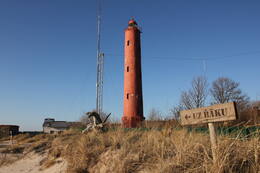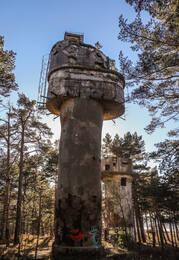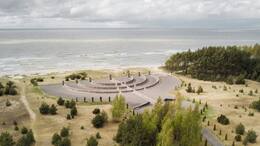“PZ" - border zone
Memories of Andris Zaļkalns, chairman of the Vērgale village council of people's deputies (1982-1989), about life in the border zone.
In 1976, I started working in the Vērgale Forestry Department as an assistant forester, working until 1982. Then I was persuaded to become the chairman of the Vērgale Village Council of People's Deputies. In the late 1980s, I left this position, worked on a collective farm for a couple of years, and in the early 1990s, I resumed work in the Vērgale Forestry Department.
When I came to Vērgale and started a family, Vērgale parish was a border zone with all the consequences that came with it. There were limited opportunities to enter, those who were registered here could travel throughout the entire zone if their passport had two letters stamped - "PZ" - sub-border zone (border zone).
Until 1995, the Liepāja - Ventspils train ran, then you could buy a ticket from Liepāja to Ventspils or vice versa, and you could get off wherever you liked. The same was true with buses. There was a route Liepāja - Aizpute in Apriķi, there was a stop "Binderi" on the route, you could get off there and get to Vērgale by whistling, but you couldn't buy a ticket until Vērgale. Cars used to be stopped on the road and documents checked, but that strict regime gradually relaxed.
It was not that easy to get to Jurmala. I remember a time when my family, which included two small children, went swimming at the seaside not far from the “Laiku” house in Ziemupe. It didn’t take long before a Russian man in kirza boots and a machine gun on his shoulder, a dog on a leash, appeared. I never understood where he came from. At that time, I had a little red book in my pocket, a service card “Lesnaya služba SSSR” (Forest Service of the USSR), I showed it, he “returned honor” and left, because as an official I had the right to stay there. The red covers and “SSSR” were very important, because it was a sure guarantee that I was not a foreign spy, and I was not going to run away.
At that time, in the territory of the village of Vērgale, if I am not mistaken, there were three military units. In Šķēde, near Liepāja, there was a border guard post, with a total staff of about 50 people. In Ziemupe there was a missile unit (“surface-to-air” missiles, which were used to shoot down planes; as far as I know, no missiles were fired from there), but in reality the missiles were there, both installed in positions and on vehicles, in combat readiness. In Saraiķi (between Ziemupe and Šķēde) there was also one unit, but what exactly – I don’t remember. There were no strategic or nuclear weapons in the territory of Vērgale.
Within the borders of the current municipality, Pāvilosta region, near Akmensrags, there were “black” or sea border guards. Pāvilosta also had border guards, as well as a base that “refueled” ships and submarines at sea.
Training was often held for military personnel, but then the local population was warned in time; the same thing is happening even now when the Latvian Army holds training.
It wasn't that there was any enmity between the two sides, the residents and the army, because over the years they had gotten used to each other. It must be said that the army men also had their benefits, they helped the municipality maintain order together with our public order guards, they kept all kinds of hooligans and vagrants away from them.
A great benefit at certain times was that we fed on them when our stores had no meat, no butter, no cigarettes, no anything else, then we would go to Ziemupi, to the rocketry unit. They had their own shop with their own supplies, they also let us shop.
It already had its benefits, because we still have untouched nature on the coast, it is unpolluted, uncultivated, undeveloped, that is the merit of the border zone. In this respect, we are already the winners, but it cannot be assessed unilaterally.
The officers' wives also got involved in local life, one was the head of the canteen in Vērgale. The village had some cooperation with the military, but this was not the case when the chairman of the collective farm grazed in a circle with a pig's leg and got cement, that was in places where construction was taking place, for example in Skrunda. But when needed, especially during holidays, they helped maintain order.
There have been and will be controls on the military personnel “from above” at all times, especially if some general from Moscow wants to catch fish and “bite”. As soon as some trouble happened, then control was inevitable. I remember when a cornfield flew from Dobele to Gotland, sometime around 1980, then the military personnel were “watched” quite a lot, and someone even lost their shoulder pads. Nothing anti-state happened here.
In Saraiķi and Ziemupė, there were places where local residents could go to the seaside during official hours. In the summer, that time was longer, in the winter it was very short. In the 1980s, the beach was no longer walked, but in the dunes, one lane was still driven over with a cultivator once or twice a day and it was not allowed to be crossed. The barbed wire was laid immediately after the war, it did not function for long. The communication line was maintained in excellent order all the time.
Fishing was done with the permission of the border guards. It was pure negotiation, because on our side of the sea it was forbidden to fish with boats. The Russians themselves wanted fish now and then, and when the time came when they wanted to drink vodka with the stalls, they found out whether there was a threat of inspections, and went fishing together. At that time, nets were not set for several days, because it was associated with repeated entry into the sea, it was not safe. The line was pulled regularly, in places where there were no rocks, both in Akmensrags and on the Šķēde side.
We fished regularly. I remember catching such huge eels, 96 eels in one go, nothing better!
Related timeline
Related objects
Akmeņrags Lighthouse and the fate of the "Saratov"
The Akmeņrags Lighthouse is located in Saka parish, 10 kilometres southwest of Pāvilosta. The top of the lighthouse can be reached by a spiral staircase and it offers views of the sea and the surrounding forests. Standing at 37 metres high, the current lighthouse tower was built in 1921, while the previous lighthouse was destroyed during World War I.
The Akmeņrags Lighthouse stands out among other lighthouses in Latvia, as it is located in one of the most dangerous places for sailing in the entire Baltic Sea coast. The signal beam of the lighthouse marks a rocky bank, which extends approximately two nautical miles or 3.7 kilometres into the sea in a north-western direction. The depth of the bank is just over two metres. The location of the lighthouse has remained unchanged, but the coastline has been receding over the years. Although a navigation light has been here since 1879, Akmeņrags has seen several shipwrecks. The most notable occurred in September 1923 when a Latvian steamer named Saratow struck the ground. In 1919, Saratow briefly served as the seat of the Latvian Provisional Government. Akmeņrags used to be home to a border guard post, and buildings of the Soviet Army are can be viewed here.
Karosta, the Military port of Liepāja (tour)
The Karosta is the largest historical military territory in the Baltics and occupies almost one third of the entire territory of Liepāja. The Karosta is a unique compound of military and fortification buildings on the shores of the Baltic Sea with a special meaning in the history and architecture of Latvia and the world. The Karosta features such military heritage sites as the North Pier and forts, the Redan, Karosta Prison, Karosta Water Tower, St. Nicholas Orthodox Maritime Cathedral, Oskars Kalpaks Bridge and others.
Memorial to the victims of holocaust in Liepāja
The largest memorial to Holocaust victims in Latvia is located in Liepāja, in the Šķēde dunes. The memorial is dedicated to the memory of more than 3,000 Liepāja Jews killed during World War II. It is in the form of the Israeli national symbol, a seven-branched candelabra known as the menorah. The contours of the memorial, which are clearly visible from a bird’s eye view, are made of split boulders and granite blocks. The ‘lights’ of the menorah are made of granite pillars with inscriptions of verses from the Lamentations of Jeremiah in Hebrew, English, Latvian and Russian.







